Developing a broad vocabulary of guitar chords is invaluable for any aspiring musician, whether you’re learning your favorite songs or writing your own. The prospect of memorizing countless chords can seem daunting, potentially taking years to achieve. However, the secret lies in understanding Guitar Chord Forms.
This lesson will introduce you to 10 essential guitar chord forms. Mastering these shapes will dramatically accelerate your learning process. Instead of rote memorization of individual chords, you’ll learn fundamental shapes that can be adapted to play dozens of different chords across the fretboard. This approach significantly enhances your ability to visualize chord progressions and navigate chord changes on the guitar with speed and confidence.
Power Chords
Power chords are the bedrock of rock guitar. You’ll find them in virtually every rock anthem and hard rock riff you admire.
A power chord is defined by its simple structure: just three notes – the root, fifth, and octave. The chord’s name is derived from its root note, the lowest note in the voicing. For instance, a power chord played with its root on the 5th fret of the Low E string is an A Power Chord, often denoted as A5.
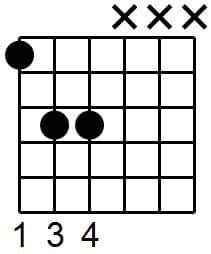 Power chord diagram showing root on the low E string for A5 chord
Power chord diagram showing root on the low E string for A5 chord
This versatile shape can be easily transposed by shifting it up and down the neck, maintaining the same finger pattern. You can also root this power chord shape on the A string for different voicings and tonal colors.
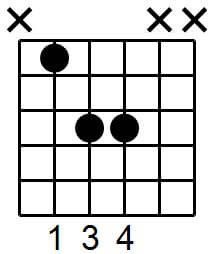 Power chord shape diagram showing root on the A string
Power chord shape diagram showing root on the A string
And even on the D string, offering further variations and adaptability across the fretboard.
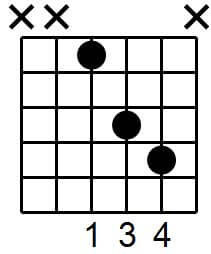 Power chord shape diagram showing root on the D string
Power chord shape diagram showing root on the D string
6 String Major Barre Chords
Barre chords, often initially perceived as challenging, are a cornerstone technique for guitarists. A barre chord involves using your index finger to press down all six strings at a specific fret, effectively acting as a ‘capo’.
The 6-string major barre chord shape is directly derived from an open E major chord. If you form an E major chord using your second, third, and fourth fingers, you’ll notice your first finger is free. By mentally shifting this E major shape up the guitar neck, your first finger becomes available to barre across all six strings, replacing the role of the open strings in the original E major chord.
Like power chords, barre chords are named after their root note, which is determined by the position of the shape on the fretboard.
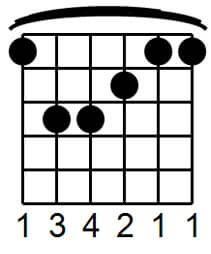 6 string major barre chord diagram based on E major shape
6 string major barre chord diagram based on E major shape
6 String Minor Barre Chords
The distinction between a 6-string major and minor barre chord hinges on a single note: the major third. In the major barre chord shape, this note is played by your middle finger on the G string.
To transform a major barre chord into a minor barre chord, you need to ‘flatten’ the major third. Flattening a note means lowering its pitch by a semitone, or one fret. In this specific instance, by removing your middle finger from the G string, you effectively flatten the third, and the barre chord automatically becomes minor because your index finger barre is already covering the minor third interval.
This minor barre chord form closely mirrors the shape of an open E minor chord.
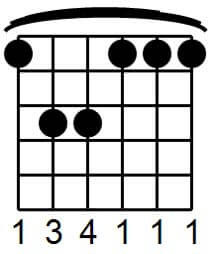 6 string minor barre chord diagram based on E minor shape
6 string minor barre chord diagram based on E minor shape
5 String Major Barre Chords
Major barre chords can also be rooted on the A string. This variation takes its shape from an open A major chord form. This particular shape can be a bit more challenging to master initially, but exploring video tutorials, like those on the Blackstar YouTube channel, can provide helpful shortcuts and techniques for efficient execution.
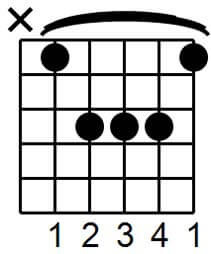 5 string major barre chord diagram based on A major shape
5 string major barre chord diagram based on A major shape
5 String Minor Barre Chords
Similar to the 6-string counterpart, converting a 5-string major barre chord into a minor chord is achieved by flattening the major third. In this A-string rooted shape, the major third is located on the B string. By adjusting your fingering to flatten this third, your barre chord morphs into a minor chord, resembling the shape of a standard open A minor chord.
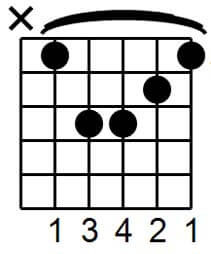 5 string minor barre chord diagram based on A minor shape
5 string minor barre chord diagram based on A minor shape
6 String Dominant 7 Chords
Dominant 7th chords are powerful tools to inject a bluesy or jazzy flavor into your chord progressions. This 6-string dominant 7th chord form is derived from a regular 6-string major barre chord. The modification is simple: just lift your little finger from the high E string. The note your pinky finger was playing is an octave of the root note, and removing it allows you to implicitly add the b7 (flat 7th) interval to the chord, creating the dominant 7th sound.
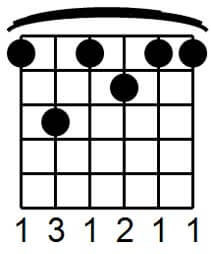 6 string dominant 7 chord diagram based on major barre shape
6 string dominant 7 chord diagram based on major barre shape
5 String Dominant 7 Chords
Following the same principle as the 6-string version, the 5-string dominant 7th chord is built upon the 5-string major barre chord shape. Simply adjust your fingers to effectively lower the major third to a minor third, introducing the characteristic b7 interval and creating a dominant 7th sound.
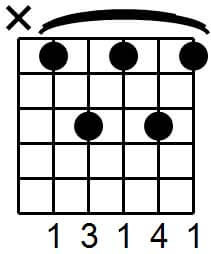 5 string dominant 7 chord diagram based on major barre shape
5 string dominant 7 chord diagram based on major barre shape
6 String Minor 7 Chords
While dominant 7th chords contain a major third interval, and can function as major chords in some contexts, you can transform them into minor 7th chords by flattening that major third. This 6-string minor 7th form is easily achieved from the 6-string dominant 7th chord shape. Just remove the middle finger that was fretting the note on the G string.
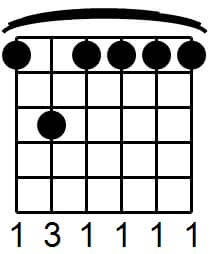 6 string minor 7 chord diagram derived from dominant 7 shape
6 string minor 7 chord diagram derived from dominant 7 shape
5 String Minor 7 Chords
This principle of flattening the major third to create a minor 7th chord can also be applied to the 5-string barre chord shapes. By making the necessary finger adjustments to flatten the third in the 5-string shape, you unlock the 5-string minor 7th chord form.
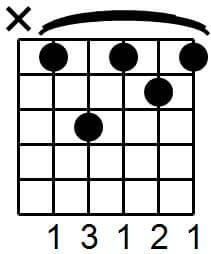 5 string minor 7 chord diagram based on minor barre shape
5 string minor 7 chord diagram based on minor barre shape
7#9 Chords (The Hendrix Chord)
Finally, we arrive at a truly iconic and expressive chord: the 7#9 chord, famously known as the Hendrix chord. This chord is a favorite for rock and blues styles, adding a distinctive funky and dissonant edge.
While the ‘7’ in its name suggests a dominant 7th chord, the 7#9 is actually a modified or “restacked” dominant 7th. It features the root on the A string, the major third on the D string, and the b7 on the G string. Notably, it omits the 5th from the major scale, which is typically present in a full dominant 7th chord. The defining characteristic of the 7#9 chord is the note on the B string – the #9 (sharp 9th).
This unique combination of intervals gives the 7#9 chord its signature sound, making it perfect for funky blues rhythms and adding a touch of harmonic complexity to your playing.
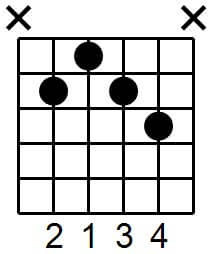 7#9 chord diagram, also known as the Hendrix chord
7#9 chord diagram, also known as the Hendrix chord
